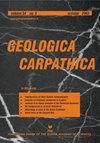From subduction to collision: Genesis of the Variscan granitic rocks from the Tatric Superunit (Western Carpathians, Slovakia)
IF 1.5
4区 地球科学
Q4 GEOSCIENCES, MULTIDISCIPLINARY
引用次数: 9
Abstract
Granitic rocks from the core mountains of the Tatric Superunit (Western Carpathians, Slovakia) were dated by means of the sensitive high-resolution ion microprobe (SHRIMP) zircon U–Th–Pb method. The dated granitic rocks yielded a broad interval of the Concordia ages from 365 ± 5 Ma to 332 ± 3 Ma and largely invalidated the former hypothesis of a duality/antagonism in emplacement ages of the Variscan Sand I-type granites (Mississippian vs. Pennsylvanian) in the Central Western Carpathians (CWC). Generally, the obtained magmatic ages cluster in two separate intervals reflecting different stages of orogeny. The older, Famennian–Tournaisian event (365–350 Ma) was related to subduction of the Rheic Ocean, whereas the younger, mostly Visean event (348–332 Ma) was associated with collisional melting. The Th/U ratios of analysed zircons are compatible mainly with their magmatic origin (Th/U > 0.2), while the lower ones (Th/U < 0.1) in some zircons can indicate competition for Th with monazite and allanite, commonly present in the analysed granitic rocks. The new dating confirmed common zircon inheritance in Western Carpathian granites with inherited zircon cores showing the Neo-Archean to Paleo-Proterozoic (2800–1690 Ma) and Ediacaran to Late Ordovician (623–448 Ma) ages. The lack of any significant differences in magmatic/emplacement ages and the common “dirty” or hybrid character of both Iand S-type granites in the CWC indicate that the melted, often mixed sources and/or subsequent modification by hybridization and assimilation processes were mostly responsible for their general “alphabetic” designation (I-/S-type).从俯冲到碰撞:斯洛伐克喀尔巴阡山脉西部塔特里克超单元中Variscan花岗岩的成因
采用高分辨离子探针(SHRIMP)锆石U-Th-Pb测年方法,研究了斯洛伐克喀尔巴阡山脉西部泰特里亚超单元岩心山花岗岩的年代。这些花岗岩的定年结果显示,在365±5 Ma到332±3 Ma之间存在较大的Concordia年龄间隔,这在很大程度上否定了之前关于喀尔巴阡山脉中西部地区瓦里西坎砂i型花岗岩(密西西比期和宾夕法尼亚期)侵位年龄的二元/对抗性假设。通常,获得的岩浆年龄聚集在两个独立的区间,反映了不同的造山阶段。较老的Famennian-Tournaisian事件(365-350 Ma)与Rheic Ocean的俯冲有关,而较年轻的Visean事件(348-332 Ma)与碰撞融化有关。锆石的Th/U比值主要与其岩浆成因相适应(Th/U < 0.2),部分锆石的Th/U比值较低(Th/U < 0.1)表明锆石与花岗岩中常见的独居石和allanite竞争Th。新定年证实了西喀尔巴阡山脉花岗岩的共同锆石继承,继承的锆石岩心显示了新太古代至古元古代(2800-1690 Ma)和埃迪卡拉纪至晚奥陶世(623-448 Ma)的年龄。岩浆/侵位年龄无明显差异,陆、s型花岗岩均具有“脏”或杂化特征,这表明熔融的混合源和/或随后的杂化和同化作用的改造是其一般“字母”命名(I-/ s型)的主要原因。
本文章由计算机程序翻译,如有差异,请以英文原文为准。
求助全文
约1分钟内获得全文
求助全文
来源期刊

Geologica Carpathica
地学-地球科学综合
CiteScore
2.40
自引率
23.10%
发文量
26
审稿时长
>12 weeks
期刊介绍:
GEOLOGICA CARPATHICA covers a wide spectrum of geological disciplines including geodynamics, tectonics and structural geology, volcanology, stratigraphy, geochronology and isotopic geology, karstology, geochemistry, mineralogy, petrology, lithology and sedimentology, paleogeography, paleoecology, paleobiology and paleontology, paleomagnetism, magnetostratigraphy and other branches of applied geophysics, economic and environmental geology, experimental and theoretical geoscientific studies. Geologica Carpathica , with its 60 year old tradition, presents high-quality research papers devoted to all aspects not only of the Alpine-Carpathian-Balkanian geoscience but also with adjacent regions originated from the Mediterranean Tethys and its continental foreland. Geologica Carpathica is an Official Journal of the Carpathian-Balkan Geological Association.
 求助内容:
求助内容: 应助结果提醒方式:
应助结果提醒方式:


